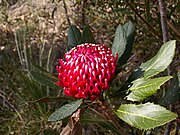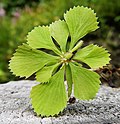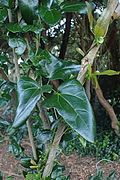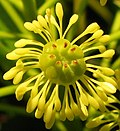List of basal eudicot families

| Flowering plant families (APG IV) | |||||
|---|---|---|---|---|---|
| | |||||
| Early-diverging flowering plants | |||||
| Monocots: Alismatids • Commelinids • Lilioids | |||||
| | |||||
Eudicots
|
The basal eudicots are a group of 13 related families of flowering plants in four orders: Buxales, Proteales, Ranunculales and Trochodendrales.[1][a] Like the core eudicots (the rest of the eudicots), they have pollen grains with three colpi (grooves) or other derived structures,[4] and usually have flowers with four or five petals (sometimes multiples of four or five, sometimes reduced or fused).[5] Unlike other eudicots, they sometimes have flowers with petals in twos or multiples of two.[6]
The basal eudicots include trees, shrubs, woody vines and herbaceous plants.[7] Cultivars of Buxus are used for hedges and topiary, and the high-quality wood is commonly used for decorative carvings and musical instruments.[8] The sacred lotus is the national flower of India and Vietnam, and the waratah is the floral emblem of the Australian state of New South Wales.[9] The opium poppy, Papaver somniferum, a source of morphine, was cultivated thousands of years ago in Mesopotamia.[10] Macadamia nuts are mainly grown in Hawaii and Australia.[11]
The orders Dilleniales and Gunnerales are basal within the core eudicots. Species of Gunnerales often have serrate (serrated) leaves, with flowers similar to those of Buxales. The epidermis and hairs on species of Dilleniales are often full of silica.[12][13]
Glossary
[edit]From the glossary of botanical terms:
- annual: a plant species that completes its life cycle within a single year or growing season
- basal: attached close to the base (of a plant or an evolutionary tree diagram)
- climber: a vine that leans on, twines around or clings to other plants for vertical support
- deciduous: shedding or falling seasonally, as with bark, leaves, or petals
- glandular hair: a hair tipped with a secretory structure
- herbaceous: not woody; usually green and soft in texture
- perennial: lives for more than two years
- unisexual: bearing only male or only female reproductive organs (i.e. not bisexual)
- woody: hard and lignified; not herbaceous[14]
The APG IV system is the fourth in a series of plant taxonomies from the Angiosperm Phylogeny Group.[2]
Dilleniales and Gunnerales families
[edit]| Family and a common name[13][b] | Type genus and etymology[c] | Total genera; global distribution | Description and uses | Order[13] | Type genus images |
|---|---|---|---|---|---|
| Dilleniaceae (guineaflower family) | Dillenia, for Johann Jacob Dillenius (1684–1747)[16][17] | 11 genera, throughout the tropics and extending into Asia and Australia[16][18] | Shrubs, trees, woody vines and a few herbaceous plants. Dillenia and Hibbertia species are grown as ornamentals, and some Dillenia fruits are edible.[19][16] | Dilleniales[16] | |
| Gunneraceae (giant-rhubarb family) | Gunnera, for Johan Ernst Gunnerus (1718–1773)[20] | 1 genus, in the Southern Hemisphere and low northern latitudes[21][22] | Small to very large herbaceous plants, usually perennials, with nitrogen-fixing bacteria. The genus is planted along pond edges in many temperate gardens.[23][20] | Gunnerales[20] | |
| Myrothamnaceae (resurrection-shrub family) | Myrothamnus, from Greek for "perfume bush"[24] | 1 genus, in East Africa and Madagascar[24][25] | Fragrant unisexual shrubs. This genus is the only woody resurrection plant; at the end of the dry season, the leaves resuscitate and turn green after wetting.[24][26] | Gunnerales[24] |
Basal eudicot families
[edit]| Family and a common name[27] | Type genus and etymology | Total genera; global distribution | Description and uses | Order[27] | Type genus images |
|---|---|---|---|---|---|
| Berberidaceae (barberry family) | Berberis, from an Arabic plant name[28][29][30] | 13 genera, in temperate zones worldwide[31][32] | Deciduous and evergreen shrubs, small trees and herbaceous perennials. Berberis fruits are sometimes used in cooking. The genus hosts stem rust, which can infest cereal grains.[23][31] | Ranunculales[31] | |
| Buxaceae (box family) | Buxus, from a Latin plant name[33][34][35] | 6 genera, on all continents except Australia and Antarctica[36][37] | Mostly shrubs and trees, usually without hairs or scales. Pachysandra terminalis is planted as a shade-loving evergreen ground cover.[19][38] | Buxales[38] | |
| Circaeasteraceae (witch's-star family) | Circaeaster, for Circe, a witch of Greek myth[39][40] | 2 genera, scattered in Asian montane habitats[41][42] | Herbaceous perennials and annuals[41] | Ranunculales[41] | |
| Eupteleaceae (Asian-elm family) | Euptelea, from Greek for "good elm"[43] | 1 genus, in a variety of temperate zones in Asia[44][45] | Deciduous shrubs and trees with spirally arranged leaves. Both species are grown as ornamental trees.[44] | Ranunculales[44] | |
| Lardizabalaceae (zabala-fruit family) | Lardizabala, for Manuel de Lardizábal y Uribe (1744–1824), a politician[46][47] | 7 genera, in southern South America and temperate East Asia[46][48] | Woody vines, including climbers, and a few shrubs. Akebia quinata is a temperate garden ornamental, and its shoots are sometimes used in vegetable tempura in Japan.[23][46] | Ranunculales[46] | |
| Menispermaceae (moonseed family) | Menispermum, from Greek for "moon seeds"[49][50] | 76 genera, most in tropical rainforests[51][52] | Woody vines, along with some shrubs, small trees and herbaceous plants. The arrow poison curare is made from Chondodendron.[19][51] | Ranunculales[51] | |
| Nelumbonaceae (sacred-lotus family) | Nelumbo, from a Sinhalese plant name[53] | 1 genus, in North America and southern and East Asia, in zones ranging from temperate to tropical[54][55] | Herbaceous aquatic perennials with underground rhizomes that produce tubers. The tubers and seeds are popular in Asian cuisine. Leaf surfaces have superhydrophobic wax. [23][54] | Proteales[54] | |
| Papaveraceae (poppy family) | Papaver, from a Latin plant name[56][57][58] | 45 genera, mostly in temperate zones north of the equator[59][60] | Mostly herbaceous annuals and perennials, with a few shrubs and fewer trees. Poppy seeds are widely used in baked goods. Papaver somniferum is harvested to produce opiates, including morphine.[59][61] | Ranunculales[59] | |
| Platanaceae (plane-tree family) | Platanus, from a Greek plant name[62][63] | 1 genus, in parts of North America, Europe and Asia.[64][65] | Tall deciduous trees with peeling bark. Plane (sycamore) wood is durable, and traditionally used for butcher's blocks. The hairs on new shoots can cause an allergic reaction.[23][64] | Proteales[64] | |
| Proteaceae (sugarbush family) | Protea, for Proteus, a Greek god[66][67] | 80 genera, mainly in the Southern Hemisphere, especially in Australia[68][69] | Trees and shrubs, usually with bisexual flowers. Banksia, Leucadendron, Protea and other genera are grown as ornamentals and for the cut-flower trade. Chilean hazelnuts are eaten in South America and New Zealand.[61][70] | Proteales[70] | |
| Ranunculaceae (buttercup family) | Ranunculus, from Latin for "little frog" (some species are aquatic)[71][72][73] | 50 genera, worldwide, mostly in temperate zones[74][75] | Herbaceous plants, woody vines and small shrubs. Many genera are popular garden plants, including Aconitum, Anemone, Aquilegia, Clematis, Delphinium, Ranunculus and Thalictrum.[23][74] | Ranunculales[74] | |
| Sabiaceae (pao-hua family) | Sabia, from a Hindi plant name[76][77] | 3 genera, in tropical and warm temperate East Asia and Central and South America[76][78] | Evergreen and deciduous shrubs, trees and woody vines[23][76] | Proteales[76] | Meliosma simplicifolia (type genus not pictured) |
| Trochodendraceae (wheel-tree family) | Trochodendron, from Greek for "wheel" (of stamens) and "tree"[79][80][81] | 2 genera, in subtropical and temperate East Asia[82][83] | Evergreen shrubs and trees with spirally arranged leaves and limited vascular systems[82] | Trochodendrales[82] |
See also
[edit]Notes
[edit]- ^ The taxonomy (classification) in this list follows Plants of the World (2017)[1] and the fourth Angiosperm Phylogeny Group system.[2] Total counts of genera for each family come from Plants of the World Online.[3] (See the POWO license.) Extinct taxa are not included.
- ^ Each family's formal name ends in the Latin suffix -aceae and is derived from the name of a genus that is or once was part of the family.[15]
- ^ Some plants were named for naturalists (unless otherwise noted).
Citations
[edit]
- ^ a b Christenhusz, Fay & Chase 2017.
- ^ a b Angiosperm Phylogeny Group 2016.
- ^ POWO.
- ^ Judd & Olmstead 2004, p. 1627.
- ^ Christenhusz, Fay & Chase 2017, pp. 115, 213.
- ^ Stevens 2023, Eudicots.
- ^ Christenhusz, Fay & Chase 2017, pp. 213–231.
- ^ Christenhusz, Fay & Chase 2017, p. 228.
- ^ Christenhusz, Fay & Chase 2017, pp. 224, 226.
- ^ Christenhusz, Fay & Chase 2017, p. 216.
- ^ Christenhusz, Fay & Chase 2017, p. 226.
- ^ Stevens 2023, Gunnerales,Dilleniales.
- ^ a b c Christenhusz, Fay & Chase 2017, pp. 229–231.
- ^ Christenhusz, Fay & Chase 2017, pp. 638–670.
- ^ ICN, art. 18.
- ^ a b c d Christenhusz, Fay & Chase 2017, p. 231.
- ^ IPNI, Dilleniaceae, Type.
- ^ POWO, Dilleniaceae.
- ^ a b c POWO, Flora of Tropical East Africa.
- ^ a b c Christenhusz, Fay & Chase 2017, pp. 229–230.
- ^ Kubitzki 2007, pp. 2–7.
- ^ POWO, Gunneraceae.
- ^ a b c d e f g POWO, Neotropikey.
- ^ a b c d Christenhusz, Fay & Chase 2017, p. 229.
- ^ POWO, Myrothamnaceae.
- ^ POWO, Flora of Zambesiaca.
- ^ a b Christenhusz, Fay & Chase 2017, pp. 213–229.
- ^ Stearn 2002, p. 63.
- ^ Coombes 2012, p. 64.
- ^ IPNI, Berberidaceae, Type.
- ^ a b c Christenhusz, Fay & Chase 2017, pp. 219–220.
- ^ POWO, Berberidaceae.
- ^ Stearn 2002, p. 74.
- ^ Coombes 2012, p. 73.
- ^ IPNI, Buxaceae, Type.
- ^ Kubitzki 2007, p. 2.
- ^ POWO, Buxaceae.
- ^ a b Christenhusz, Fay & Chase 2017, pp. 227–228.
- ^ Burkhardt 2018, p. C-40.
- ^ IPNI, Circaeasteraceae, Type.
- ^ a b c Christenhusz, Fay & Chase 2017, pp. 216–217.
- ^ POWO, Circaeasteraceae.
- ^ Stearn 2002, p. 136.
- ^ a b c Christenhusz, Fay & Chase 2017, p. 214.
- ^ POWO, Eupteleaceae.
- ^ a b c d Christenhusz, Fay & Chase 2017, p. 217.
- ^ IPNI, Lardizabalaceae, Type.
- ^ POWO, Lardizabalaceae.
- ^ Stearn 2002, p. 205.
- ^ IPNI, Menispermaceae, Type.
- ^ a b c Christenhusz, Fay & Chase 2017, p. 218.
- ^ POWO, Menispermaceae.
- ^ Stearn 2002, p. 216.
- ^ a b c Christenhusz, Fay & Chase 2017, pp. 223–224.
- ^ POWO, Nelumbonaceae.
- ^ Stearn 2002, p. 230.
- ^ Coombes 2012, p. 223.
- ^ IPNI, Papaveraceae, Type.
- ^ a b c Christenhusz, Fay & Chase 2017, pp. 215–216.
- ^ POWO, Papaveraceae.
- ^ a b POWO, Flora of West Tropical Africa.
- ^ Stearn 2002, p. 243.
- ^ Coombes 2012, p. 237.
- ^ a b c Christenhusz, Fay & Chase 2017, pp. 224–225.
- ^ POWO, Platanaceae.
- ^ Stearn 2002, p. 249.
- ^ IPNI, Proteaceae, Type.
- ^ Kubitzki 2007, p. 12.
- ^ POWO, Proteaceae.
- ^ a b Christenhusz, Fay & Chase 2017, pp. 225–226.
- ^ Stearn 2002, p. 255.
- ^ Coombes 2012, p. 251.
- ^ IPNI, Ranunculaceae, Type.
- ^ a b c Christenhusz, Fay & Chase 2017, p. 220.
- ^ POWO, Ranunculaceae.
- ^ a b c d Christenhusz, Fay & Chase 2017, pp. 222–223.
- ^ IPNI, Sabiaceae, Type.
- ^ POWO, Sabiaceae.
- ^ Stearn 2002, p. 300.
- ^ Coombes 2012, p. 293.
- ^ IPNI, Trochodendraceae, Type.
- ^ a b c Christenhusz, Fay & Chase 2017, pp. 226–227.
- ^ POWO, Trochodendraceae.
References
[edit]- Angiosperm Phylogeny Group (2016). "An update of the Angiosperm Phylogeny Group classification for the orders and families of flowering plants: APG IV". Botanical Journal of the Linnean Society. 181 (1): 1–20. doi:10.1111/boj.12385.
- Burkhardt, Lotte (2018). Verzeichnis eponymischer Pflanzennamen – Erweiterte Edition [Index of Eponymic Plant Names – Extended Edition] (pdf) (in German). Berlin: Botanic Garden and Botanical Museum, Freie Universität Berlin. doi:10.3372/epolist2018. ISBN 978-3-946292-26-5. S2CID 187926901. Retrieved January 1, 2021. See the Creative Commons license.
- Christenhusz, Maarten; Fay, Michael Francis; Chase, Mark Wayne (2017). Plants of the World: An Illustrated Encyclopedia of Vascular Plants. Chicago, Illinois: Kew Publishing and The University of Chicago Press. ISBN 978-0-226-52292-0.
- Coombes, Allen (2012). The A to Z of Plant Names: A Quick Reference Guide to 4000 Garden Plants. Portland, Oregon: Timber Press. ISBN 978-1-60469-196-2.
- IPNI (2022). "International Plant Names Index". London, Boston and Canberra: Royal Botanic Gardens, Kew; Harvard University Herbaria & Libraries; and the Australian National Botanic Gardens. Retrieved December 20, 2022.
- Judd, Walter S.; Olmstead, Richard G. (2004). "A survey of tricolpate (eudicot) phylogenetic relationships". American Journal of Botany. 91 (10): 1627–44. doi:10.3732/ajb.91.10.1627. PMID 21652313.
- Kubitzki, K. (2007). "Introduction to the Groups Treated in This Volume". In Kubitzki, K. (ed.). Berberidopsidales, Buxales, Crossosomatales, Fabales p.p., Geraniales, Gunnerales, Myrtales p.p., Proteales, Saxifragales, Vitales, Zygophyllales, Clusiaceae Alliance, Passifloraceae Alliance, Dilleniaceae, Huaceae, Picramniaceae, Sabiaceae. Vol. IX. Springer. pp. 2–7, 12. ISBN 978-3-540-32214-6.
- POWO (2019). "Plants of the World Online". London: Royal Botanic Gardens, Kew. Retrieved January 1, 2023. See their terms-of-use license.
- Stearn, William (2002). Stearn's Dictionary of Plant Names for Gardeners. London: Cassell. ISBN 978-0-304-36469-5.
- Stevens, P.F. (2023) [2001]. "Angiosperm Phylogeny Website". Missouri Botanical Garden. Retrieved January 2, 2023.
- Turland, N. J.; et al. (eds.). International Code of Nomenclature for algae, fungi, and plants (Shenzhen Code) adopted by the Nineteenth International Botanical Congress Shenzhen, China, July 2017 (electronic ed.). Glashütten: International Association for Plant Taxonomy. Retrieved February 25, 2022.

































